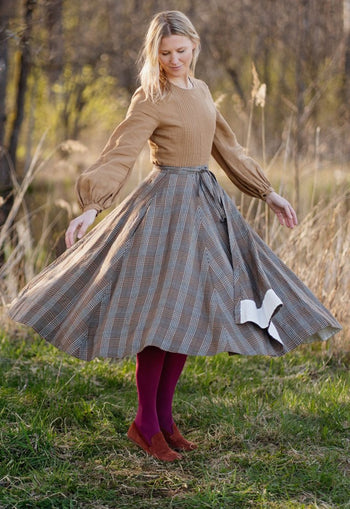How to Soften Linen Sheets and Beddings? Ultimate Guide
One of life’s simple joys is sleeping in a cozy bed, covered by soft sheets, and surrounded by fluffy pillows - the most fantastic feeling in the world!
One fabric that stands out from the rest at home use, especially in the bedroom used for beddings and sheets, is linen.
However, we have noticed, that some new linen sheets elsewhere can really feel more crisp than soft.
We will guide you on how to soften your linen sheets and beddings at home with highly recommended ideas, solutions, and effective methods from our experience you could do anytime in the comfort of your home.

Quick Tips To Make Linen Sheets Softer
-
Gentle detergent: Always choose a liquid detergent that is gentle. Bleach and powdered detergents can weaken linen fibers, making them less soft over time.
-
Cool Water: Linen likes water that is cold. When you wash linens in hot water, the fibers can get stiff, which makes the washing process harder.
-
Avoid Overcrowding: If the washing machine is too full, the cloth pieces may rub against each other too much, which stops the linen from naturally softening. On its own or with other similar materials, linen should be washed.
-
Natural Drying: The best way to dry linen is to let it air dry. Put the sheets in the machine on low heat and take them out while they're still a little damp. In this way, the fibers will not get stiff.
-
Initial Wash: Begin by washing your linen sheets before you first use them, starting the softening process immediately.
-
Consistent Cleaning: Continually washing your linen sheets will gradually soften the material. Always adhere to the recommended washing guidelines.
-
Baking Soda Method: Incorporate about half a cup of baking soda into your wash cycle to naturally soften the linen fabric.
- Tennis Balls Technique: Use several tennis balls in the dryer with your linen sheets or beddings. The balls will help break down the rigid fibers, resulting in softer linen.
Now let's dive more in depth.
Is Linen Scratchy?
Let's start from the one of the known misconceptions with linen is its texture is quite rough and scratchy to touch.
The scratchiness of brand new linen may be the effect or cause of the treatment used by the manufacturer to produce linen such as chemicals and starching.
These agents are the culprit in bringing out the scratchy feeling of linen fabric that irritates human skin. Similarly, the certified and high-quality organic linen is soft to touch fresh from the box.
But this has never been a compelling reason for many to shy away from linen beddings. Simply because of linen's prominent and inherent nature, it gets softer with time.
Why Does Linen Keep Getting Softer With Time?
Linen is widely recognized for its moisture wick ability and inherent absorbency in the textile industry.
This intrinsic nature is the key to linen's striking characteristic: it gets softer and more absorbent after multiple washings - what makes it more extraordinary is that no fabric softener is necessary to achieve this.
Luckily, we know some helpful and effective ways how to soften linen sheets and beddings at home yourself.
We are so happy to share with you our significant collection of practical and insightful ideas and recommendations we have experienced as #linenlovers.

Detailed Tip on How to Soften Linen Sheets and Beddings
Here are some suggestions and expert advice that will guide you on how to soften and maintain the luxuriousness of your linen beddings and sheets for a longer time in the comfort of your home.
1. Washing Linen More Often
Washing is the first process we undertake for softening linen beddings at home.
With this being said, it is necessary to read the manufacturer's care instructions first. But based on our personal experiences, it is best to wash it in cold water and put it in a gentle cycle.
After washing, it is best if you let it air-dry it outside, or, if needed, put it on a dryer setting the heat temperature low, and later put on the dryer set for a low-speed setting.
Linen has a unique character among other textiles that most people love; it gets softer, shinier, and even more comfortable and cozier after every wash.With this, linen is easy to care for and maintain, but this conventional method requires a lot of time and patience because there is no fixed number of washes you need to achieve the softness you want for your linen sheets.
More importantly, with vigorous washing, your linen will feel less scratchy afterward since the more you wash it, the more it loses the excess lint causing linen fabric to feel rough.
Yet, this simple technique ensures that your favorite linen will last for more than a decade, and at the same time, it gets softer and softer over time.
You can utilize one of the commonly known benefits of using natural fabric softening solutions readily available in almost every househould on the planet.At the same time, you could do several traditional methods used by our ancestors and still being practiced today by many linen lovers and users worldwide.
Keep on scrolling as we will answer one by one all the most frequently asked questions about linen’s journey from being stiff to soft to feel in every manner and way possible.

2. Try Baking Soda Work to Soften Linen Beddings and Bedsheets
Are you aware that baking soda is a natural cleaner and surprisingly a great fabric softener?
Baking soda can definitely boost the softening process of linen.
Yes, it is proven and tested how great baking soda instantly softens linen fabric even in the first washing cycle using this natural cleaning powder.
So, how baking soda works?
Baking soda has a pH of 9, scientifically tested to be good enough to soften linen sheets.
This kitchen staple is considered an alkali that manages the pH level inside your washer, inhibiting the water you use to wash the linen, be it hand washing or machine washing, to become too acidic or too alkaline, damaging the linen fabric.
Not to mention, it also is a natural cleaning powder that removes all the unnecessary substance or stench on your linen fabrics.
- Machine wash with a mixture of detergent and baking soda is the most popular and conventional method done by most linen lovers worldwide.
To do this, you have to add a 1/2 cup of baking soda and your delicate detergent on every wash cycle of your linen beddings and bedsheets. This technique prevents any deposit from detergent and mineral from water from redepositing onto your sheets.
- The soaking technique is so easy and manageable that almost everyone can do it.
All you need to do is fill in the tub with a 5-gallon bucket of warm water and then dissolve at least 1/2 cup of baking soda. If you put on more linen fabrics, add accordingly. Soak and submerge the linen sheets in the tub with the dissolved baking soda for at least 24 hours (maximum of 48 hours) for the softening process to happen.
After the waiting process, you can opt to let its line dry or machine wash them. Scientifically speaking, the more baking soda you use in this solution, the more significant the softening effect will be.
- Handwash with baking soda - If you have all the time to handwash your sheets.
All you have to do is pour at least 1/2 to a full cup of baking soda into the water (depending on the load before washing). Let it dissipate in a moment, and then, you can handwash it normally and line-dry it afterward.

3. Use Vinegar to Soften Linen
Yes, vinegar is one of the most commonly used household items as an alternative fabric softener. In particular, white vinegar serves as a natural fabric softener.
You might be thinking:
How does vinegar works?
White vinegar has an approximate pH level of 2.5, making it highly acidic responsible for loosening the scratchy fibers inside the fabric, minimizing its stiffness and roughness, transforming the material to be soft and relatively smooth to touch.
- Alternative to chemical fabric softener
When you prefer to machine wash your linen sheets, we suggest replacing the chemical fabric softener by making a solution with 1/2 cup of vinegar and 1/2 cup of water.
- Rinse with vinegar before washing
This means you have to rinse the linen sheets in the washing machine in 1/2 cup of pure white vinegar as an alternative to your washing powder. Afterwards, rewash linen in a regular washing cycle using your preferred detergent.
- Soaking technique
This means you have to soak and submerge linen sheets and beddings overnight in a solution that is a mixture of 1 cup white vinegar and 1 gallon of water. After that, wash it in a usual manner in the washing machine.
4. Try Dryer Balls To Soften Linen
Dryer balls are also used to soften the linen fabric, which is considered the best alternative to chemical and toxic fabric softeners available today in the market.
There are available in various shapes, colors, and materials (e.g., rubber, plastic), but the most commonly used dryer balls are made of pure wool.
How do dryer balls work?
The dryer balls prevent your laundry from clumping together during the drying process, allowing the hot air to circulate, giving room for the natural fibers to separate.
That is why it is enough to put at least 2-3 dryer balls into the dryer that will speed up the drying process up to 25% while providing you with softer, more likable, and comfier linen sheets.
If dryer balls are not available at home, you could look for tennis balls. Surprisingly, they would actually soften and speed up the drying process with your linen laundry.

Other Solutions and Effective Methods to Soften the Linen
- You can benefit from using white vinegar and baking soda in one washing cycle.
Either use one on the pre-soak or the other during washing to increase the chance of your linen sheets' chance of softer and comfier in one washing. Take note that mixing white vinegar and baking soda into one solution will not work since one is alkali and acid in its natural composition. You can only opt to have one natural fabric softener dissolved in water, either white vinegar or baking soda, to have what you need, softer and comfier linen sheets after.
- Ironing is not necessary on linen fabric, but it helps to soften the material more quickly.
For this to work, iron your linen on high heat while the fabric is still damp, or use a press cloth if necessary. Please keep in mind not to use any finishing spray.
- When you line-dry linen sheets, place them in an excellent breezy area outside, or if placed inside your house, direct a fan at the fabric as it dries.
What is the Universal Length of Time for Linen Sheets to Soften?
No absolute or universal timeframe can be set on how long it will take for linen to soften.
No one can determine precisely how long to soften linen sheets because not all linens are made the same way or process at all.
Some factors will clearly affect the stiffness and roughness of linen in the same manner also dictates the timeframe on how long it will take for it to soften, namely: the quality of the fabric, quality of the weave, and the method you choose to impose in your fresh out of the box linen.
Again, there is no definite time to determine the length of time linen sheets will soften.
More importantly, the tips and tricks we share with you above are not "miracle methods" that will instantly cure the stiffness of your linen. It may take on more than one washing to achieve your goal, or if it's your lucky day, you might have softened linen after doing at least one of these tricks in one washing.
What is Softened Linen?
If you do not have the indulgence of time and effort to soften linen with the abovementioned practices, we highly recommend you to purchase “softened linen.”
This variation of linen fabric has undergone a different kind of process than regular linen fabric. Specifically, for softened linen to produce, what is missing with the process is the utilization of chemical additives.
In short, there are no chemicals used to make the fabric, and it is commonly referred to as "organic linen."
However, the downside is that it is more expensive than regular linen.
Fortunately, purchasing softened linen instead saves you a lot of time and effort since you do not have to do any of the tricks mentioned above, and you will have the luxury to use your linen sheets, soft and comfy, fresh out of the box.
What is the Softest Linen Fabric?
Linen fabric, in general, is soft, but certain factors and parameters in play can predict the softness of linen.
First parameter that can tell how soft linen fabric is is the quality of the weave pattern.
Here are the following examples we hoped to guide you in choosing the most delicate linen fabric in the softness category.
Based on Weave Pattern:
- Plain woven linen
Comes in loosely woven pattern fabrics featured often in a striped or checkered pattern. This variant of linen has been used for a hand towel and kitchen towels or napkin, which appears to be textured and rough because the fibers are highly durable, so the stiffness or roughness is quite noticeable, especially for newly purchased ones. But this variant is highly absorbent, so it will get softer and softer after every wash.
- Damask linen
This variation has satin and plain woven pattern fabric commonly used for linen decoration and is widely known as the smoothest linen fabric.
- Sheeting linen
It has a close weave pattern fabric produced with a higher thread count commonly used for bed sheets. Because of its higher thread count and tight weave fiber pattern, this kind of linen fabric needs to be washed first before using so that linen fibers will be loosened, stimulating your linen sheets' softening process. Take note that the softness of this kind of linen depends on your choice of washing method, and the softening process will transform its stiffness into softness in due time.
- Loosely woven linen
See the following types of 100% pure linen fabrics below for your reference to know the softest linen fabric you can buy.

Based on the Quality and Origin of Linen:
- Belgian Linen
This is one of the most exceptional linen fabrics globally, basically produced in Belgian linen flax grown native in Belgium and other European regions.
This kind of linen comes with an Authentic Belgian Linen trademark which only those who pass the rigorous selection process granted the brandmark "Masters of Linen."
Only a few thousand are given authority and have excellent expertise to weave the special linen in Belgium. This kind of linen is well-known for its softness and remarkable quality unparalleled to last for a lifetime or two.
- French Linen
This is rated second to Belgian linen in terms of softness and quality. Though Belgian can be identified through its trademark, this kind of linen doesn't have a brandmark or registered trademark labeled in its linen.
But this doesn't mean they can easily ignore the craftsmanship and durability of French linen. In reality, the top choices for bedsheets are Belgian and French linen because you will not be disappointed in choosing one over the other.
- Japanese Linen
This type of linen is what most fashion designers and linen lovers referred as the "underdogs in the linen world." Simply because most of this type of linen is produced by well-known families with a generation of experience crafting and trading Japanese linens worldwide.
They do not commercialize or advertise their linen products compared to other kinds of linen. But one thing you can trust about this kind of linen is how it was produced in the first place with innate Japanese work ethos: great attention to detail.
Their linen fabrics are made ideally soft, comfortable, and cozy. So if the brand is not too important to you, you can opt to buy Japanese linen that is well-recognized worldwide to be soft and comfortable linen.
- Lithuanian Linen
We are so incredibly happy to be able to use this wonderful best-quality linen produced locally which every step of growth we do have an honor to follow and make sure it would be taken with best care.
Lithuanian linen is sourced and produced in Northern Europe, popularly recognized for its finest craftsmanship.
Lithuanians love linen fabrics and celebrate a festival in honor of flax! Because of this fondness, there is no doubt that they knew a lot of traditional methods to produce and manufacture comfortable and soft linen fabrics well-prized for their rich quality standard.
Final Thoughts
Linen beddings and bedsheets are among the most tricky items to purchase because of the wide range of selections available in the market, be it online stores or boutique shops.
Most mass-produced linens can be quite rough textured at first since not being professionally pre-softened which, we believe, might make non-linen users question its rising popularity and demand.
With this, as certified #linenlovers, we assure you that whichever linen you purchase it can can absolutely be fixed and softened the way you want it to be, and your hesitations will go away for good, transforming you to be one of us, a #linenlover for good, undoubtedly.
We hope this article helps you in the moment of doubt when having raw linen bed bedding or sheets which would need some extra help to soften.
If you have some rough-textured or stiff linen bed sheets, we have shared are most useful practices on how to soften them safely, guaranteeing you to have softer, fluffier pillows and comfier beds every night for the rest of your life.
Browse our home linen production and find top quality linen items.




